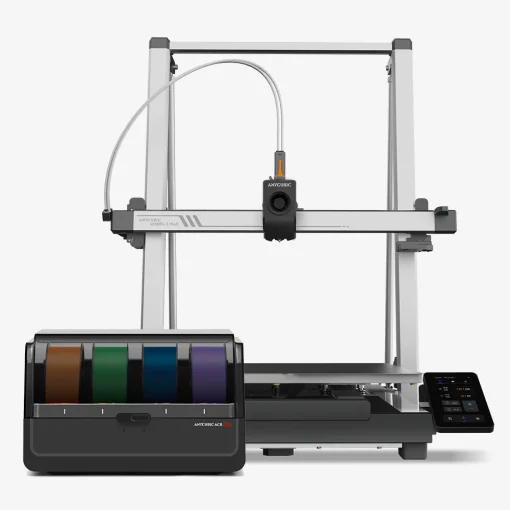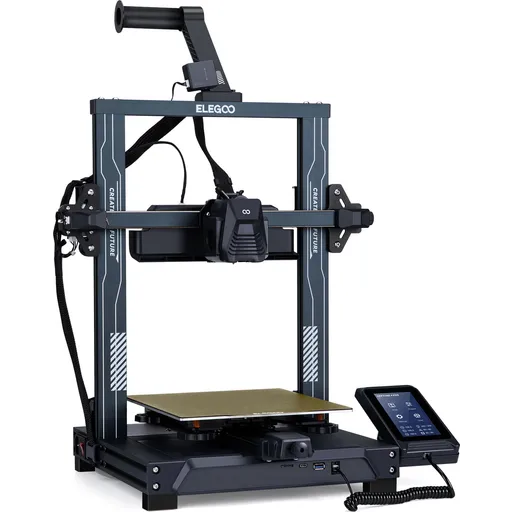Compare Kobra 3 Max Combo vs Neptune 4 PRO
Comparison between the best 3D printers
Choose the best 3D printer at the best price. The cheapest 3D printers are here.
Buy a 3D printer here with 3D Fila.
 |
 |
|
| Model | Kobra 3 Max Combo |
Neptune 4 PRO |
| Printing Material | Filament | Filament |
| Buy Filament for Anycubic Kobra 3 Max Combo | Buy Filament forElegoo Neptune 4 PRO | |
| Estimated price | $699,00 | $359,00 |
| Manufacturer | Anycubic | Elegoo |
| Release Year | 2025 | 2023 |
| Print Volume [mm] | 420x420x500 | 225x225x265 |
| Printer Size [mm] | 640x753x706 | 475x445x515 |
| Weight [kg] | 23,6 | 8,9 |
| Power Loss Recovery | YES | YES |
| Enclosed printer | NO | NO |
| Bed Leveling | Automatic | Automatic |
| Filament End Sensor | YES | YES |
| Bed type | Heated | Heated |
| Power supply system | Bowden | Direct Drive |
| Standard nozzle | 0,4 | 0,4 |
| Maximum Nozzle Temperature [°C] | 300 | 300 |
| Maximum Bed Temperature [°C] | 90 | 110 |
| Maximum printing speed [mm/s] | 600 | 500 |
| Filament holder | YES | YES |
| Camera for supervision | YES | YES |
| Recommended filaments | PLA, PETG, TPU | PLA, PLA+, TPU, PETG, Nylon, ABS |
| Recommended slicers | Anycubic Slicer, Cura, Orca Slicer | Bambu Studio, Super Slicer, Cura, Prusa Slicer, Orca |
| Maximum Resolution [mm] | 0,01 | 0,1 |
| Processor | ARM 64 bit | |
| Display | Touchscreen 4,3'' | Touchscreen 4,3'' |
| Power Supply | 800 W | 310 W |
| Connectivity | USB, Wifi | USB, microSD |
| Operating systems | Windows, Mac, Linux | Windows, Linux, Macbook |
| Date of registration in the system | 2025-03-06 | 2024-07-02 |
| Release date | 2025 | 2023 |
| Extra features | The Anycubic Kobra 3 Max Combo combines high-speed and multicolor printing with up to 8 colors. It features automatic leveling, quick filament switching, clog and entanglement detection, and AI to prevent print failures. Its 800W hotbed heats up quickly, while 10,000mm/s² acceleration ensures efficiency. App and Wi-Fi control, print recovery, and video monitoring enhance the user experience. | The Elegoo Neptune 4 Pro stands out for its advanced features, including pre-installed Klipper firmware, a dual-gear direct extruder with a 5.2:1 ratio, a high-temperature nozzle (up to 300°C), a flexible magnetic PEI platform, efficient cooling fans, and a 121-point auto-leveling system. The printer also features a 4.3-inch touchscreen interface, dual linear bars on the X and Y axes, and a segmented heated bed for energy savings. |
| Support for multiple colors and materials (AMS and CFS) | YES | NO |
Notes * |
||
| Cost-benefit | 7 / 10 | 7 / 10 |
| Hardware | 5.4 / 10 | 2.8 / 10 |
| Tela | . | . |
| Print volume | 4 / 10 | 3 / 10 |
| Performance | 5 / 10 | 4 / 10 |
Conclusion |
| When comparing the Anycubic Kobra 3 Max Combo and the Elegoo Neptune 4 PRO, several factors stand out that may guide potential buyers in making an informed decision. The Anycubic Kobra 3 Max Combo is positioned as a feature-rich 3D printer offering advanced functionalities such as high-speed multicolor printing, automatic leveling, and an efficient cooling system. Its larger print volume allows for the creation of more sizable models, appealing to users who require versatility in their projects. The printer's ability to handle multiple colors and materials enhances its overall utility, while the robust 800W power supply ensures rapid heating and efficient performance. However, its higher price point reflects these added features, which may not be essential for all users. On the other hand, the Elegoo Neptune 4 PRO emerges as a more budget-friendly option, making it an attractive choice for hobbyists or those new to 3D printing. While it has a smaller print volume and somewhat fewer advanced features, it still incorporates key functionalities such as dual-gear direct extruder and effective auto-leveling. Its power supply and efficient design offer satisfactory performance, but it may not match the Kobra in terms of speed or overall versatility. Ultimately, the decision between these two printers largely depends on user priorities—whether one opts for the advanced capabilities of the Kobra at a higher price or the practicality and affordability of the Neptune 4 PRO. Both printers deliver good performance for their respective price points, but potential buyers should carefully assess their specific needs, project requirements, and budget constraints before making a selection. |

